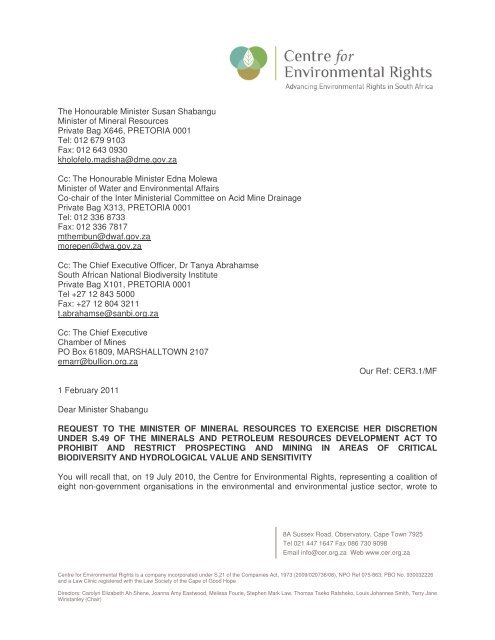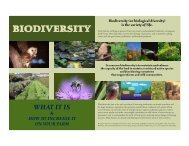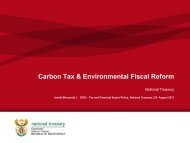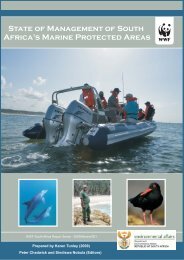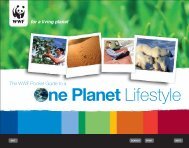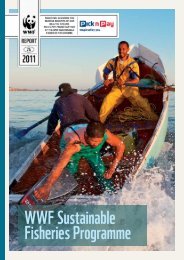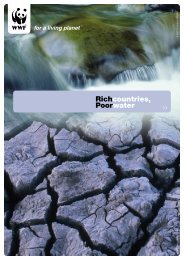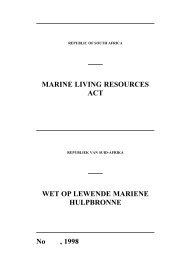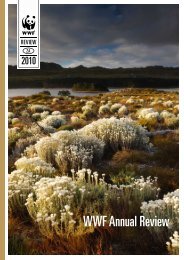CER Letter to Minister Shabangu re MPRDA s49 - 1 Feb 2011
CER Letter to Minister Shabangu re MPRDA s49 - 1 Feb 2011
CER Letter to Minister Shabangu re MPRDA s49 - 1 Feb 2011
Create successful ePaper yourself
Turn your PDF publications into a flip-book with our unique Google optimized e-Paper software.
The Honourable <strong>Minister</strong> Susan <strong>Shabangu</strong><br />
<strong>Minister</strong> of Mineral Resources<br />
Private Bag X646, PRETORIA 0001<br />
Tel: 012 679 9103<br />
Fax: 012 643 0930<br />
kholofelo.madisha@dme.gov.za<br />
Cc: The Honourable <strong>Minister</strong> Edna Molewa<br />
<strong>Minister</strong> of Water and Environmental Affairs<br />
Co-chair of the Inter <strong>Minister</strong>ial Committee on Acid Mine Drainage<br />
Private Bag X313, PRETORIA 0001<br />
Tel: 012 336 8733<br />
Fax: 012 336 7817<br />
mthembun@dwaf.gov.za<br />
mo<strong>re</strong>pen@dwa.gov.za<br />
Cc: The Chief Executive Officer, Dr Tanya Abrahamse<br />
South African National Biodiversity Institute<br />
Private Bag X101, PRETORIA 0001<br />
Tel +27 12 843 5000<br />
Fax: +27 12 804 3211<br />
t.abrahamse@sanbi.org.za<br />
Cc: The Chief Executive<br />
Chamber of Mines<br />
PO Box 61809, MARSHALLTOWN 2107<br />
emarr@bullion.org.za<br />
Our Ref: <strong>CER</strong>3.1/MF<br />
1 <strong>Feb</strong>ruary <strong>2011</strong><br />
Dear <strong>Minister</strong> <strong>Shabangu</strong><br />
REQUEST TO THE MINISTER OF MINERAL RESOURCES TO EXERCISE HER DISCRETION<br />
UNDER S.49 OF THE MINERALS AND PETROLEUM RESOURCES DEVELOPMENT ACT TO<br />
PROHIBIT AND RESTRICT PROSPECTING AND MINING IN AREAS OF CRITICAL<br />
BIODIVERSITY AND HYDROLOGICAL VALUE AND SENSITIVITY<br />
You will <strong>re</strong>call that, on 19 July 2010, the Cent<strong>re</strong> for Environmental Rights, <strong>re</strong>p<strong>re</strong>senting a coalition of<br />
eight non-government organisations in the environmental and environmental justice sec<strong>to</strong>r, wrote <strong>to</strong><br />
8A Sussex Road, Observa<strong>to</strong>ry, Cape Town 7925<br />
Tel 021 447 1647 Fax 086 730 9098<br />
Email info@cer.org.za Web www.cer.org.za<br />
Cent<strong>re</strong> for Environmental Rights is a company incorporated under S.21 of the Companies Act, 1973 (2009/020736/08), NPO Ref 075-863, PBO No. 930032226<br />
and a Law Clinic <strong>re</strong>giste<strong>re</strong>d with the Law Society of the Cape of Good Hope<br />
Di<strong>re</strong>c<strong>to</strong>rs: Carolyn Elizabeth Ah Shene, Joanna Amy Eastwood, Melissa Fourie, Stephen Mark Law, Thomas Tseko Ratsheko, Louis Johannes Smith, Terry Jane<br />
Winstanley (Chair)
you and the <strong>Minister</strong> of Water and Environmental Affairs, congratulating both <strong>Minister</strong>s on the<br />
establishment of a joint task team on mining in sensitive a<strong>re</strong>as.<br />
In our letter, we also offe<strong>re</strong>d <strong>to</strong> submit <strong>to</strong> you a list of geographical a<strong>re</strong>as of the most critical<br />
biodiversity and hydrological value and/or sensitivity in South Africa, for the purpose of public<br />
consultation <strong>to</strong>wards a declaration of these a<strong>re</strong>as as prohibited or <strong>re</strong>stricted for commercial<br />
prospecting and mining under s.49 of the Minerals and Petroleum Resources Development Act, 2002<br />
(Act 28 of 2002) (<strong>MPRDA</strong>). We stated that this list would be based on extensive scientific <strong>re</strong>search,<br />
mapping and other work undertaken by provincial conservation authorities, the Departments of<br />
Environmental Affairs and Water Affairs, the South African National Biodiversity Institute (SANBI) and<br />
the CSIR, and consulted and ag<strong>re</strong>ed between key civil society stakeholders.<br />
After extensive consultation amongst various non-government organisations, we a<strong>re</strong> now in a position<br />
<strong>to</strong> provide you with such a list, which we attach in the form of a formal proposal on behalf of thirteen<br />
non-government and civil society organisations. We believe that protecting a<strong>re</strong>as of such critical value<br />
through a prohibition on prospecting and mining is in the national inte<strong>re</strong>st and in compliance with a<br />
wide range of legislative imperatives, including the Constitution of the Republic of South Africa. We<br />
further believe such a declaration will promote the sustainable development of the nation’s mineral<br />
<strong>re</strong>sources, and assist our country in mitigating and adapting <strong>to</strong> the impacts of climate change.<br />
We have also noted that, since our letter of 19 July 2010:<br />
government has committed itself <strong>to</strong> the identification of “national a<strong>re</strong>as… for <strong>re</strong>stricted mineral<br />
development” in the Outcome 10 Delivery Ag<strong>re</strong>ement of September 2010; and<br />
the<strong>re</strong> have been calls from the mining industry for the clear identification of environmentally<br />
sensitive a<strong>re</strong>as in which mining should not be allowed, in order <strong>to</strong> avoid fruitless investment by<br />
mining companies in such a<strong>re</strong>as. 1<br />
We understand that making a declaration under s.49 of the <strong>MPRDA</strong> is a complex matter, and as nongovernment<br />
organisations we a<strong>re</strong> p<strong>re</strong>pa<strong>re</strong>d <strong>to</strong> engage with the Ministry and the Department of Mineral<br />
Resources on the attached proposal. We trust that you will in any event seek the advice of SANBI,<br />
who is best placed <strong>to</strong> provide independent counsel on this particular matter.<br />
Yours since<strong>re</strong>ly<br />
CENTRE FOR ENVIRONMENTAL RIGHTS<br />
per:<br />
On behalf of the following NGOs and CSOs, in alphabetical order:<br />
BirdLife South Africa (www.birdlife.org.za)<br />
Cent<strong>re</strong> for Applied Legal Studies (http://web.wits.ac.za/Academic/CLM/LAW/CALS)<br />
Cent<strong>re</strong> for Environmental Rights (www.cer.org.za)<br />
Earthlife Africa Johannesburg (www.earthlife.org.za)<br />
Endange<strong>re</strong>d Wildlife Trust (www.ewt.org.za)<br />
Environmental Moni<strong>to</strong>ring Group (www.emg.org.za)<br />
Federation for a Sustainable Environment (www.fse.org.za)<br />
Game Rangers Association of Africa (www.gameranger.org)<br />
National Association of Conservancies/Stewardship of SA (www.nacsa.org.za)<br />
South Durban Community Environmental Alliance (www.sdcea.co.za)<br />
Wilderness Foundation (www.wildernessfoundation.co.za)<br />
1 See, for example, “Mo<strong>re</strong> clarity needed on SA mining rules” in MiningMX 28 Oc<strong>to</strong>ber 2010, available at<br />
http://www.miningmx.com/news/energy/mo<strong>re</strong>-clarity-needed-on-sa-mining-rules.htm
Wildlife and Environment Society of South Africa (www.wessa.org.za)<br />
WWF South Africa (www.wwf.org.za)
Proposal <strong>to</strong> <strong>Minister</strong> of Mineral Resources <strong>to</strong> exercise her disc<strong>re</strong>tion under<br />
s.49 of the Minerals and Petroleum Resources Development Act, 2002 <strong>to</strong><br />
prohibit or <strong>re</strong>strict the granting <strong>re</strong>connaissance, prospecting and mining<br />
rights and permits<br />
Barber<strong>to</strong>n Mountainlands (Pho<strong>to</strong>: Mervyn Lotter)<br />
BirdLife South Africa (www.birdlife.org.za)<br />
Cent<strong>re</strong> for Applied Legal Studies (http://web.wits.ac.za/Academic/CLM/LAW/CALS)<br />
Cent<strong>re</strong> for Environmental Rights (www.cer.org.za)<br />
Earthlife Africa Johannesburg (www.earthlife.org.za)<br />
Endange<strong>re</strong>d Wildlife Trust (www.ewt.org.za)<br />
Environmental Moni<strong>to</strong>ring Group (www.emg.org.za)<br />
Federation for a Sustainable Environment (www.fse.org.za)<br />
Game Rangers Association of Africa (www.gameranger.org)<br />
National Association of Conservancies/Stewardship of SA (www.nacsa.org.za)<br />
South Durban Community Environmental Alliance (www.sdcea.co.za)<br />
Wilderness Foundation (www.wildernessfoundation.co.za)<br />
Wildlife and Environment Society of South Africa (www.wessa.org.za)<br />
WWF South Africa (www.wwf.org.za)<br />
1. Purpose<br />
This is a formal application by thirteen non-government and civil society organisations <strong>to</strong> the <strong>Minister</strong><br />
of Mineral Resources <strong>to</strong> exercise her disc<strong>re</strong>tion under s.49 of the Minerals and Petroleum Resources<br />
Development Act, 2002 (Act 28 of 2002) (<strong>MPRDA</strong>), having <strong>re</strong>gard <strong>to</strong> the national inte<strong>re</strong>st and the need<br />
<strong>to</strong> promote the sustainable development of the nation’s mineral <strong>re</strong>sources, <strong>to</strong>:<br />
prohibit the granting of any <strong>re</strong>connaissance permission, prospecting right, mining right or<br />
mining permit in <strong>re</strong>spect of certain a<strong>re</strong>as of critical biodiversity, conservation and hydrological<br />
importance; and
impose <strong>re</strong>strictions on the granting of any <strong>re</strong>connaissance permission, prospecting right,<br />
mining right or mining permit in <strong>re</strong>spect of other a<strong>re</strong>as of biodiversity, conservation and<br />
hydrological importance,<br />
for an indefinite period until the circumstances which caused the <strong>Minister</strong> so <strong>to</strong> prohibit or <strong>re</strong>strict no<br />
longer exist.<br />
2. Background<br />
The exploitation of mineral <strong>re</strong>sources is a key tenet of the South African economy. However, the<br />
natu<strong>re</strong> of mining (both underground and surface mining) is such that it has both significant di<strong>re</strong>ct and<br />
indi<strong>re</strong>ct impacts on the biophysical environment. This includes impacts on soil, water <strong>re</strong>sources (both<br />
groundwater and surface water), geological stability, aquatic and marine biodiversity, ter<strong>re</strong>strial<br />
biodiversity, and air quality. All of these elements a<strong>re</strong> essential for human health and wellbeing, and it<br />
is the<strong>re</strong>fo<strong>re</strong> of the utmost importance that the detrimental impacts of mining – evidence of which is<br />
becoming mo<strong>re</strong> visible every day, such as in the case of acid mine drainage on the Witwatersrand –<br />
a<strong>re</strong> appropriately controlled and mitigated.<br />
In addition, mining contributes both di<strong>re</strong>ctly and indi<strong>re</strong>ctly <strong>to</strong> climate change, and has been identified<br />
as a key sec<strong>to</strong>r in climate change adaptation and mitigation in the most <strong>re</strong>cent National Climate<br />
Change Response Strategy 2010 cur<strong>re</strong>ntly out for comment. 2 This Strategy describes the th<strong>re</strong>ats of<br />
climate change <strong>to</strong> both water <strong>re</strong>sources and ter<strong>re</strong>strial and marine biodiversity, and <strong>re</strong>commends<br />
interventions that include the following:<br />
encouraging and facilitating the building of partnerships <strong>to</strong> enable effective management of<br />
a<strong>re</strong>as not under formal protection and investment in the expansion of key protected a<strong>re</strong>as<br />
(which we<strong>re</strong> not originally designed with climate change t<strong>re</strong>nds in mind) in line with the most<br />
robust knowledge of climate change impacts; 3<br />
ensuring that protected a<strong>re</strong>a planning and expansion strategies benefit from an eco-system<br />
approach and focus <strong>to</strong> ensu<strong>re</strong> that th<strong>re</strong>atened biomes, landscapes and species a<strong>re</strong> given<br />
special protection and that conditions a<strong>re</strong> established that will minimise the risks of species<br />
extinction; 4<br />
implementing integrated water <strong>re</strong>source management including protecting and <strong>re</strong>s<strong>to</strong>ring natural<br />
systems; 5 and<br />
vigorously enforcing compliance with water quality standards <strong>to</strong> ensu<strong>re</strong> that our water <strong>re</strong>mains<br />
fit for use, and that clean water is available for blending <strong>to</strong> dilute pollutants. Contamination by<br />
salts, excessive nutrients, heavy metals and other pollutants must be <strong>re</strong>stricted. 6<br />
In September 2010, national government launched the so-called Outcome 10 Delivery Ag<strong>re</strong>ement, a<br />
“negotiated charter which <strong>re</strong>flects the commitment of the key partners involved in the di<strong>re</strong>ct delivery<br />
process <strong>to</strong> working <strong>to</strong>gether”. This charter <strong>re</strong>corded the following:<br />
“The inability of the cur<strong>re</strong>nt spatial planning and land use management system <strong>to</strong> integrate<br />
mineral development has <strong>re</strong>sulted in the latter occurring in a<strong>re</strong>as whe<strong>re</strong> it permanently<br />
sterilised a<strong>re</strong>as of high agricultural potential or impacted seve<strong>re</strong>ly on sensitive and prioritised<br />
ecosystems. Mineral development priority a<strong>re</strong>as should with equal standing “compete” in a<br />
spatial planning and land use management system with other policy imperatives such as<br />
biodiversity protection, food security, water security, etc. The inclusion of mineral development<br />
in the spatial planning and land use management system and identification of ag<strong>re</strong>ed “mining<br />
<strong>re</strong>striction a<strong>re</strong>as” is accordingly an important step in doing things diffe<strong>re</strong>ntly <strong>to</strong>wards achieving<br />
the desi<strong>re</strong>d outcome.”<br />
2 For example: “Certain mining operations, especially large-scale open-caste mines, <strong>re</strong>duce natural carbonsequestration<br />
capacity and may also <strong>re</strong>sult in inc<strong>re</strong>ased water st<strong>re</strong>ss due <strong>to</strong> water use and/or pollution.” (p.18)<br />
3 P.22<br />
4 P.22<br />
5 P.9<br />
6 P.10
The Delivery Ag<strong>re</strong>ement committed government <strong>to</strong> the following <strong>re</strong>sults and targets (sub-output 3.4):<br />
“National a<strong>re</strong>as negotiated and published by 2015 identified for <strong>re</strong>stricted mineral development:<br />
Moni<strong>to</strong>ring and enforcement of mining activities (ongoing)<br />
Comparison of ‘environmentally sensitive a<strong>re</strong>as’ and ‘mineral development priority a<strong>re</strong>as’<br />
by December 2012<br />
Public and stakeholder consultation by June 2013<br />
Gazette <strong>re</strong>stricted mineral development a<strong>re</strong>as in terms of s.49 of the <strong>MPRDA</strong> by April<br />
2014”<br />
As civil society organisations, we welcome this commitment by government, and he<strong>re</strong>by provide input<br />
as early as possible in the process described in the Outcome 10 Delivery Ag<strong>re</strong>ement in<strong>to</strong> the<br />
identification of a<strong>re</strong>as in which prospecting and mining should be either prohibited or made subject <strong>to</strong><br />
<strong>re</strong>strictions.<br />
However, we also call on government <strong>to</strong> accelerate the process outlined in the Outcome 10 Delivery<br />
Ag<strong>re</strong>ement. We believe that, based on existing <strong>re</strong>search and consultation, it is possible and necessary<br />
<strong>to</strong> start a public consultation process far earlier than 2013, and we a<strong>re</strong> of the view that the proposal<br />
contained in this submission is an excellent, well-motivated starting point for such public consultation.<br />
We also believe that our nation cannot afford any further loss of a<strong>re</strong>as of the most critical biodiversity<br />
and hydrological value and/or sensitivity, and the<strong>re</strong>fo<strong>re</strong> <strong>re</strong>gard this matter as urgent.<br />
3. Legal context<br />
Below we briefly set out the legal context for this proposal.<br />
3.1. The Constitution<br />
<br />
S.24 of the Constitution of the Republic of South Africa, 1996 provides that everyone has the right (a)<br />
<strong>to</strong> the environment that is not harmful <strong>to</strong> their health or wellbeing; and (b) <strong>to</strong> have the environment<br />
protected, for the benefit of p<strong>re</strong>sent and futu<strong>re</strong> generations, through <strong>re</strong>asonable legislative and other<br />
measu<strong>re</strong>s that (i) p<strong>re</strong>vent pollution and ecological degradation; (ii) promote conservation; and (iii)<br />
secu<strong>re</strong> ecologically sustainable development and use of natural <strong>re</strong>sources while promoting justifiable<br />
economic and social development.<br />
S.27(1)(b) of the Constitution also guarantees everyone sufficient food and water, which should be<br />
interp<strong>re</strong>ted <strong>to</strong> mean edible food and potable water; mining in inappropriate a<strong>re</strong>as poses di<strong>re</strong>ct th<strong>re</strong>ats<br />
<strong>to</strong> drinking water and food production.<br />
S.41(1)(h)(iv) of the Constitution <strong>re</strong>qui<strong>re</strong>s all organs of state <strong>to</strong> cooperate with one another in mutual<br />
trust and good faith by coordinating their actions and legislation with one another. This <strong>re</strong>qui<strong>re</strong>s organs<br />
of state like the Departments of Mineral Resources, Water Affairs and Environmental Affairs <strong>to</strong> ensu<strong>re</strong><br />
that the implementation of their <strong>re</strong>spective legislation is coordinated, and that their <strong>re</strong>spective<br />
legislative mandates can be fulfilled in line with the Constitution.<br />
<br />
3.2. The National Environmental Management Act and specific environmental management acts<br />
<br />
NEMA establishes principles for decision-making on matters affecting the environment. These<br />
principles apply <strong>to</strong> all organs of state that may significantly affect the environment and “shall apply<br />
alongside all other appropriate and <strong>re</strong>levant considerations, including the State's <strong>re</strong>sponsibility <strong>to</strong><br />
<strong>re</strong>spect, protect, promote and fulfil the social and economic rights in Chapter 2 of the Constitution and<br />
in particular the basic needs of categories of persons disadvantaged by unfair discrimination”. 7 The<br />
principles serve as guidelines by <strong>re</strong>fe<strong>re</strong>nce <strong>to</strong> which any organ of state must exercise any function<br />
when taking any decision in terms of this Act or any statu<strong>to</strong>ry provision concerning the protection of<br />
7 S.2(1)(a)
the environment, 8 and guide the interp<strong>re</strong>tation, administration and implementation of this Act, and any<br />
other law concerned with the protection or management of the environment. 9<br />
NEMA p<strong>re</strong>scribes that “sustainable development” <strong>re</strong>qui<strong>re</strong>s consideration of fac<strong>to</strong>rs that include the<br />
following:<br />
(i)<br />
(ii)<br />
(iii)<br />
(iv)<br />
(v)<br />
(vi)<br />
that the disturbance of ecosystems and loss of biological diversity a<strong>re</strong> avoided, or, whe<strong>re</strong><br />
they cannot be al<strong>to</strong>gether avoided, a<strong>re</strong> minimised and <strong>re</strong>medied;<br />
that pollution and degradation of the environment a<strong>re</strong> avoided, or, whe<strong>re</strong> they cannot be<br />
al<strong>to</strong>gether avoided, a<strong>re</strong> minimised and <strong>re</strong>medied;<br />
that the disturbance of landscapes and sites that constitute the nation's cultural heritage<br />
is avoided, or whe<strong>re</strong> it cannot be al<strong>to</strong>gether avoided, is minimised and <strong>re</strong>medied;<br />
that waste is avoided, or whe<strong>re</strong> it cannot be al<strong>to</strong>gether avoided, minimised and <strong>re</strong>-used<br />
or <strong>re</strong>cycled whe<strong>re</strong> possible and otherwise disposed of in a <strong>re</strong>sponsible manner;<br />
that the use and exploitation of non-<strong>re</strong>newable natural <strong>re</strong>sources is <strong>re</strong>sponsible and<br />
equitable, and takes in<strong>to</strong> account the consequences of the depletion of the <strong>re</strong>source;<br />
that the development, use and exploitation of <strong>re</strong>newable <strong>re</strong>sources and the ecosystems<br />
of which they a<strong>re</strong> part do not exceed the level beyond which their integrity is jeopardised;<br />
(vii) that a risk-averse and cautious approach is applied, which takes in<strong>to</strong> account the limits of<br />
cur<strong>re</strong>nt knowledge about the consequences of decisions and actions; and<br />
(viii) that negative impacts on the environment and on people's environmental rights be<br />
anticipated and p<strong>re</strong>vented, and whe<strong>re</strong> they cannot be al<strong>to</strong>gether p<strong>re</strong>vented, a<strong>re</strong><br />
minimised and <strong>re</strong>medied. 10<br />
Importantly for this proposal, s.2(4)(r) of NEMA provides that “sensitive, vulnerable, highly dynamic or<br />
st<strong>re</strong>ssed ecosystems, such as coastal sho<strong>re</strong>s, estuaries, wetlands, and similar systems <strong>re</strong>qui<strong>re</strong><br />
specific attention in management and planning procedu<strong>re</strong>s, especially whe<strong>re</strong> they a<strong>re</strong> subject <strong>to</strong><br />
significant human <strong>re</strong>source usage and development p<strong>re</strong>ssu<strong>re</strong>.”<br />
Two of the specific environmental management Acts promulgated under NEMA’s framework a<strong>re</strong> the<br />
National Environmental Management: Biodiversity Act, 10 of 2004 (Biodiversity Act), and the National<br />
Environmental Management: Protected A<strong>re</strong>as Act, 57 of 2004 (Protected A<strong>re</strong>as Act). Tools in both<br />
these acts will be <strong>re</strong>fer<strong>re</strong>d <strong>to</strong> in this proposal.<br />
3.3. The National Water Act<br />
The National Water Act, 1998 (Act 36 of 1998) (NWA) states its purpose <strong>to</strong> be “<strong>to</strong> ensu<strong>re</strong> that the<br />
nation’s water <strong>re</strong>sources a<strong>re</strong> protected, used, developed, conserved, managed and controlled in ways<br />
which take in<strong>to</strong> account amongst other fac<strong>to</strong>rs -<br />
(a)<br />
(b)<br />
(c)<br />
(d)<br />
(e)<br />
(f)<br />
meeting the basic human needs of p<strong>re</strong>sent and futu<strong>re</strong> generations;<br />
promoting equitable access <strong>to</strong> water;<br />
<strong>re</strong>d<strong>re</strong>ssing the <strong>re</strong>sults of past racial and gender discrimination;<br />
promoting the efficient, sustainable and beneficial use of water in the public inte<strong>re</strong>st;<br />
facilitating social and economic development;<br />
providing for growing demand for water use;<br />
8 S.2(1)(c)<br />
9 S.2(1)(e)<br />
10 S.2(4)(a)
(g)<br />
(h)<br />
(i)<br />
(j)<br />
protecting aquatic and associated ecosystems and their biological diversity;<br />
<strong>re</strong>ducing and p<strong>re</strong>venting pollution and degradation of water <strong>re</strong>sources;<br />
meeting international obligations;<br />
promoting dam safety;<br />
(k) managing floods and droughts.” 11<br />
It also states that government is the “public trustee of the nation’s water <strong>re</strong>sources” who must “ensu<strong>re</strong><br />
that water is protected, used, developed, conserved, managed and controlled in a sustainable and<br />
equitable manner, for the benefit of all persons and in accordance with its constitutional mandate.” 12<br />
The National Water Act also prioritises the determination and protection of the “<strong>re</strong>serve”, which<br />
consists of the “basic human needs <strong>re</strong>serve” and the “ecological <strong>re</strong>serve”. “Reserve” is defined in s.1<br />
of the National Water Act as “the quantity and quality of water <strong>re</strong>qui<strong>re</strong>d (a) <strong>to</strong> satisfy basic human<br />
needs by securing a basic water supply, as p<strong>re</strong>scribed under the Water Services Act, 1997 (Act No.<br />
108 of 1997), for people who a<strong>re</strong> now or who will, in the <strong>re</strong>asonably near futu<strong>re</strong>, be (i) <strong>re</strong>lying upon; (ii)<br />
taking water from; or (iii) being supplied from, the <strong>re</strong>levant water <strong>re</strong>source; and (b) <strong>to</strong> protect aquatic<br />
ecosystems in order <strong>to</strong> secu<strong>re</strong> ecologically sustainable development and use of the <strong>re</strong>levant water<br />
<strong>re</strong>source”.<br />
3.4. The Minerals and Petroleum Resources Development Act 28 of 2002<br />
The <strong>MPRDA</strong> states that its object is “<strong>to</strong> make provision for equitable access <strong>to</strong> and sustainable<br />
development of the nation’s mineral and petroleum <strong>re</strong>sources”. It also states in its p<strong>re</strong>amble that it is<br />
“the State’s obligation <strong>to</strong> protect the environment for the benefit of p<strong>re</strong>sent and futu<strong>re</strong> generations, <strong>to</strong><br />
ensu<strong>re</strong> ecologically sustainable development of mineral and petroleum <strong>re</strong>sources and <strong>to</strong> promote<br />
economic and social development”. It further states that it should “give effect <strong>to</strong> section 24 of the<br />
Constitution by ensuring that the nation’s mineral and petroleum <strong>re</strong>sources a<strong>re</strong> developed in an<br />
orderly and ecologically sustainable manner while promoting justifiable social and economic<br />
development”. 13<br />
S.3(3) of the <strong>MPRDA</strong> provides that “the <strong>Minister</strong> must ensu<strong>re</strong> the sustainable development of South<br />
Africa’s mineral and petroleum <strong>re</strong>sources within a framework of national environmental policy, norms<br />
and standards while promoting economic and social development.”<br />
S.37(1) of the <strong>MPRDA</strong> provides that the environmental management principles listed in s.2 of NEMA<br />
must guide the interp<strong>re</strong>tation, administration and implementation of the environmental <strong>re</strong>qui<strong>re</strong>ments of<br />
the <strong>MPRDA</strong>, and also makes those principles applicable <strong>to</strong> all prospecting and mining operations.<br />
S.37(2) states even mo<strong>re</strong> explicitly that “any prospecting or mining operation must be conducted in<br />
accordance with generally accepted principles of sustainable development by integrating social,<br />
economic and environmental fac<strong>to</strong>rs in<strong>to</strong> the planning and implementation of prospecting and mining<br />
projects in order <strong>to</strong> ensu<strong>re</strong> that exploitation of mineral <strong>re</strong>sources serves p<strong>re</strong>sent and futu<strong>re</strong><br />
generations.”<br />
The <strong>MPRDA</strong> itself <strong>re</strong>cognises that the<strong>re</strong> a<strong>re</strong> certain a<strong>re</strong>as that a<strong>re</strong> not appropriate for prospecting and<br />
mining activities, even if the<strong>re</strong> may be exploitable mineral <strong>re</strong>sources in such a<strong>re</strong>as. This includes,<br />
subject <strong>to</strong> the <strong>Minister</strong>’s national inte<strong>re</strong>st disc<strong>re</strong>tion described in s.48(2), <strong>re</strong>sidential a<strong>re</strong>as, public roads<br />
and railways and cemeteries. 14<br />
S.49(1) gives a specific disc<strong>re</strong>tion <strong>to</strong> the <strong>Minister</strong> <strong>to</strong>, “after inviting <strong>re</strong>p<strong>re</strong>sentations from <strong>re</strong>levant<br />
stakeholders, from time <strong>to</strong> time by notice in the Gazette, having <strong>re</strong>gard <strong>to</strong> the national inte<strong>re</strong>st and the<br />
need <strong>to</strong> promote the sustainable development of the nation’s mineral <strong>re</strong>sources, prohibit or <strong>re</strong>strict the<br />
granting of any <strong>re</strong>connaissance permission, prospecting right, mining right or mining permit in <strong>re</strong>spect<br />
11 S.2<br />
12 S.3(1)<br />
13 S.2(h)<br />
14 S.48(1)
of land identified by the <strong>Minister</strong> for such period and on such terms and conditions as the <strong>Minister</strong> may<br />
determine.” S.49(2) excludes existing rights from such a declaration. S.49(3) allows the <strong>Minister</strong> <strong>to</strong> lift<br />
a <strong>re</strong>striction or prohibition “if the circumstances which caused the <strong>Minister</strong> so <strong>to</strong> prohibit or <strong>re</strong>strict no<br />
longer exist”, or <strong>to</strong> amend the period, term or condition applicable <strong>to</strong> any prohibition or <strong>re</strong>striction“ if the<br />
circumstances which caused the <strong>Minister</strong> so <strong>to</strong> prohibit or <strong>re</strong>strict have changed”.<br />
Insofar as the interp<strong>re</strong>tation of s.49(1) goes, “sustainable development” is defined in s.1 of the <strong>MPRDA</strong><br />
as “the integration of social, economic and environmental fac<strong>to</strong>rs in<strong>to</strong> planning, implementation and<br />
decision making so as <strong>to</strong> ensu<strong>re</strong> that mineral and petroleum <strong>re</strong>sources development serves p<strong>re</strong>sent<br />
and futu<strong>re</strong> generations”; this definition must also be <strong>re</strong>ad with the fac<strong>to</strong>rs listed in s.2(4)(a) of NEMA.<br />
Similarly, any interp<strong>re</strong>tation of the phrase “national inte<strong>re</strong>st” is subject <strong>to</strong> the fac<strong>to</strong>rs listed in s.2(4)(a)<br />
of NEMA.<br />
3.5. Existing prohibitions on commercial prospecting and mining<br />
As the <strong>Minister</strong> will be awa<strong>re</strong>, the<strong>re</strong> a<strong>re</strong> al<strong>re</strong>ady a<strong>re</strong>as whe<strong>re</strong> commercial prospecting and mining a<strong>re</strong><br />
prohibited by legislation. These include the following:<br />
<br />
Sterkfontein Caves, Cradle of<br />
Humankind World Heritage<br />
Site, Gauteng<br />
Mapungubwe World Heritage Site, Limpopo<br />
3.5.1. World Heritage A<strong>re</strong>as, 15 such as the Mapungubwe World Heritage A<strong>re</strong>a in<br />
Limpopo and the Cradle of Humankind World Heritage A<strong>re</strong>a in Gauteng. In terms of<br />
s.48(1)(c) as <strong>re</strong>ad with s.9(b) of NEMPAA, commercial prospecting and mining a<strong>re</strong><br />
prohibited in decla<strong>re</strong>d World Heritage Sites.<br />
The p<strong>re</strong>amble <strong>to</strong> the World Heritage Convention Act, 1999 (Act 49 of 1999) <strong>re</strong>cords<br />
that:<br />
o “the cultural heritage and the natural heritage a<strong>re</strong> among the priceless and<br />
ir<strong>re</strong>placeable possessions, not only of the Republic, but of humankind as a<br />
whole”; and<br />
o “the loss, through deterioration, disappearance or damage through<br />
inappropriate development of any of these most prized possessions,<br />
constitutes an impoverishment of the heritage of all the peoples of the<br />
world and, in particular, the people of South Africa”.<br />
15 Decla<strong>re</strong>d in terms of the World Heritage Convention Act, 1999 (Act 49 of 1999)
Marakele National Park, Limpopo (Pho<strong>to</strong>: John Wesson)<br />
<br />
3.5.2. Special natu<strong>re</strong> <strong>re</strong>serves, national parks or natu<strong>re</strong> <strong>re</strong>serves decla<strong>re</strong>d in terms of<br />
the National Environmental Management: Protected A<strong>re</strong>as Act, 2003, 16 such as the<br />
Kruger National Park, Limpopo and the Marakele National Park, Waterberg,<br />
Limpopo. In terms of s.48(1) of NEMPAA, commercial prospecting and mining a<strong>re</strong><br />
prohibited in these a<strong>re</strong>as. Natu<strong>re</strong> <strong>re</strong>serves include natu<strong>re</strong> <strong>re</strong>serves managed by<br />
provincial authorities.<br />
<br />
<br />
<br />
S.17 of the Protected A<strong>re</strong>as Act <strong>re</strong>cords the following purposes of declaring<br />
protected a<strong>re</strong>as, including marine protected a<strong>re</strong>as. These purposes include the<br />
protection of ecologically viable a<strong>re</strong>as <strong>re</strong>p<strong>re</strong>sentative of South Africa’s biological<br />
diversity and its natural landscapes and seascapes in a system of protected a<strong>re</strong>as;<br />
<strong>to</strong> p<strong>re</strong>serve the ecological integrity of those a<strong>re</strong>as; <strong>to</strong> protect a<strong>re</strong>as <strong>re</strong>p<strong>re</strong>sentative<br />
of all ecosystems, habitats and species naturally occurring in South Africa; <strong>to</strong><br />
protect South Africa’s th<strong>re</strong>atened or ra<strong>re</strong> species; <strong>to</strong> protect an a<strong>re</strong>a which is<br />
vulnerable or ecologically sensitive; <strong>to</strong> assist in ensuring the sustained supply of<br />
environmental goods and services; <strong>to</strong> provide for the sustainable use of natural and<br />
biological <strong>re</strong>sources; <strong>to</strong> c<strong>re</strong>ate or augment destinations for natu<strong>re</strong>-based <strong>to</strong>urism; <strong>to</strong><br />
manage the inter<strong>re</strong>lationship between natural environmental biodiversity, human<br />
settlement and economic development; generally, <strong>to</strong> contribute <strong>to</strong> human, social,<br />
cultural, spiritual and economic development; or <strong>to</strong> <strong>re</strong>habilitate and <strong>re</strong>s<strong>to</strong><strong>re</strong><br />
degraded ecosystems and promote the <strong>re</strong>covery of endange<strong>re</strong>d and vulnerable<br />
species.<br />
As mentioned above, the 2010 G<strong>re</strong>en Paper on South Africa’s Climate Change<br />
Response identifies an effective, expanded protected a<strong>re</strong>as system as a key tenet<br />
of South Africa’s <strong>re</strong>sponse <strong>to</strong> climate change.<br />
3.5.3. Marine protected a<strong>re</strong>as decla<strong>re</strong>d under s.43 of the Marine Living Resources Act, 17<br />
1998 such as the Table Mountain Marine Protected A<strong>re</strong>a and the Dwesa-Cebe<br />
16 Act 57 of 2003.<br />
17 Act 18 of 1998
Marine Protected A<strong>re</strong>a. In terms of s.14(1) as <strong>re</strong>ad with s.48 of NEMPAA,<br />
commercial prospecting and mining a<strong>re</strong> prohibited in marine protected a<strong>re</strong>as.<br />
The most <strong>re</strong>cent State of the Environment Report states that: “Despite the prog<strong>re</strong>ss<br />
al<strong>re</strong>ady made <strong>to</strong> safeguard South Africa’s coastline, the urgent need <strong>re</strong>mains <strong>to</strong><br />
protect offsho<strong>re</strong> habitats, especially in the light of the impacts of offsho<strong>re</strong> fishing<br />
and mining activities on the marine environment.” 18<br />
In addition <strong>to</strong> the purposes of declaring protected a<strong>re</strong>as as set out in the Protected<br />
A<strong>re</strong>as Act, which also apply <strong>to</strong> marine protected a<strong>re</strong>as, the designation,<br />
establishment and management of marine protected a<strong>re</strong>as is an important<br />
instrument <strong>to</strong> safeguard biodiversity and the integrity of ecological processes in the<br />
coastal and marine environment. The 2010 G<strong>re</strong>en Paper on South Africa’s Climate<br />
Change Response cur<strong>re</strong>ntly out for comment mentions that “[c]limatic changes will<br />
almost certainly disturb marine ecosystems, making them mo<strong>re</strong> susceptible <strong>to</strong><br />
invasive species from lower latitudes, so that warmer water species a<strong>re</strong> likely <strong>to</strong><br />
become mo<strong>re</strong> abundant with an overall decline in cold water indigenous species.” It<br />
also highlights the likely impacts of climate change on the fisheries sec<strong>to</strong>r, and<br />
emphasises the urgent need for <strong>re</strong>search in this field.<br />
<br />
Table Mountain Marine Protected A<strong>re</strong>a, Western Cape<br />
(Pho<strong>to</strong>: Africa Geographic)<br />
<br />
Dwesa-Cebe Marine Protected A<strong>re</strong>a, Eastern Cape<br />
3.5.4. Specially protected fo<strong>re</strong>st a<strong>re</strong>as such as the Wolkberg Wilderness in Limpopo,<br />
fo<strong>re</strong>st natu<strong>re</strong> <strong>re</strong>serves and fo<strong>re</strong>st wilderness a<strong>re</strong>as decla<strong>re</strong>d in terms of the<br />
National Fo<strong>re</strong>sts Act, 1998. In terms of s.48(1)(c) as <strong>re</strong>ad with s.9(d) of NEMPAA,<br />
commercial prospecting and mining a<strong>re</strong> prohibited in these a<strong>re</strong>as.<br />
<br />
Above we have listed a<strong>re</strong>as in which commercial prospecting and mining a<strong>re</strong> al<strong>re</strong>ady prohibited by<br />
legislation. We have done so for two <strong>re</strong>asons. Firstly, we do so <strong>to</strong> illustrate that the legislatu<strong>re</strong> has<br />
al<strong>re</strong>ady <strong>re</strong>cognised that certain geographical a<strong>re</strong>as should be off-limits <strong>to</strong> such activities.<br />
Secondly, we do so because the<strong>re</strong> have been a number of instances in which prospecting and mining<br />
rights have been granted in these a<strong>re</strong>as despite the existing statu<strong>to</strong>ry prohibition, typically as a <strong>re</strong>sult<br />
of false information submitted <strong>to</strong> the Department of Mineral Resources (DMR). This leads <strong>to</strong> the<br />
unfortunate situation of forcing inte<strong>re</strong>sted and affected parties, including donor-funded nongovernment<br />
organisations, <strong>to</strong> approach a court <strong>to</strong> set aside an inappropriate and unlawful decision,<br />
<strong>re</strong>sulting in significant legal costs being incur<strong>re</strong>d unnecessarily by organisations that can ill afford such<br />
costs. This situation must be add<strong>re</strong>ssed through improved sc<strong>re</strong>ening and verification methods, and<br />
criminal prosecution of applicants who make false or misleading statements <strong>to</strong> the DMR in their<br />
applications.<br />
<br />
18 http://soer.deat.gov.za/587.html
4. Proposed prohibition<br />
Against this background, it is proposed that prospecting and mining be prohibited in the a<strong>re</strong>as listed<br />
below, without conditions and for such period until the prohibition may be lifted within the <strong>re</strong>qui<strong>re</strong>ments<br />
of s.49(3)(a).<br />
<br />
4.1. Mountain catchment a<strong>re</strong>as decla<strong>re</strong>d in terms of the Mountain Catchment A<strong>re</strong>as Act,<br />
1970 (Act 63 of 1970), such as the Amatholes in the Eastern Cape;<br />
<br />
4.2. Ramsar Sites, or sites <strong>re</strong>cognised under the Ramsar Convention on Wetlands 1971, such<br />
as Barberspan near Dela<strong>re</strong>yville, Blekbospruit near Springs, the Verlo<strong>re</strong>nvlei north of<br />
Lamberts Bay, Kosi Bay and the Turtle Beaches/Coral Reefs of Tongaland south of Kosi<br />
Bay in KwaZulu-Natal, the Nylsvlei Ramsar Reserve in Limpopo;<br />
Nylsvlei Ramsar Reserve, Limpopo (Pho<strong>to</strong>: John Wesson)<br />
<br />
The Ramsar Convention is an intergovernmental t<strong>re</strong>aty that provides the framework for<br />
national action and international cooperation for the conservation and wise use of wetlands<br />
and their <strong>re</strong>sources. The wise use of wetlands is defined as "the maintenance of their<br />
ecological character, achieved through the implementation of ecosystem approaches,<br />
within the context of sustainable development". "Wise use" the<strong>re</strong>fo<strong>re</strong> has at its heart the<br />
conservation and sustainable use of wetlands and their <strong>re</strong>sources, for the benefit of<br />
humankind. 19<br />
19 www.ramsar.org
Wakkerstroom Montane Grassland (Pho<strong>to</strong>: Mervyn Lotter)<br />
<br />
4.3. Recognised endange<strong>re</strong>d and critically endange<strong>re</strong>d ecosystems, such as<br />
Wakkerstroom-Luneberg, Mpumalanga; Chrissiesmeer, Mpumalanga; Ngoye Scarp<br />
Fo<strong>re</strong>st, KwaZulu-Natal; Dullstroom, Mpumalanga; Mananga Cycad Sanctuary,<br />
Mpumalanga; Umtamvuna coastal grassland, KwaZulu-Natal; Last fragments of<br />
Blesbokspruit Highveld Grasslands, Gauteng; and Kogelberg, Western Cape.<br />
Since 2006, at the <strong>re</strong>quest of the Department of Environmental Affairs, SANBI, in<br />
consultation with provincial conservation authorities, has led broad public consultation for<br />
the first phase of scientifically rigorous identification of endange<strong>re</strong>d and critically<br />
endange<strong>re</strong>d ecosystems in the ter<strong>re</strong>strial environment. The purpose of these lists is <strong>to</strong><br />
<strong>re</strong>duce the rate of extinction of endange<strong>re</strong>d and critically endange<strong>re</strong>d ecosystems and<br />
species and <strong>to</strong> p<strong>re</strong>serve witness sites of exceptionally high conservation value. This<br />
information is <strong>re</strong>adily available for implementation of a prohibition in terms of s.49 of the<br />
<strong>MPRDA</strong>.
Chrissiesmeer, Mpumalanga (Pho<strong>to</strong>: Ursula Francke)<br />
5. Proposed <strong>re</strong>strictions<br />
Below we propose <strong>re</strong>strictions for prospecting and mining in a<strong>re</strong>as of biodiversity and hydrological<br />
importance not included in the proposal for prohibitions above.<br />
Note that this section is based on the assumption that the Minerals and Petroleum Resources<br />
Development Amendment Act, 2008 (Act 49 of 2008) will not come in<strong>to</strong> effect in its cur<strong>re</strong>nt form. We<br />
continue our call that Act 49 of 2008 be brought in<strong>to</strong> effect as promulgated and assented <strong>to</strong> by the<br />
P<strong>re</strong>sident. The application of Chapter 5 of the National Environmental Management Act, 1998<br />
(NEMA), 20 the 2010 EIA Regulations and the Listing Notices published under the 2010 EIA<br />
Regulations will add<strong>re</strong>ss many of the issues that the <strong>re</strong>strictions in this section attempt <strong>to</strong> add<strong>re</strong>ss.<br />
However, should Act 49 of 2008 be brought in<strong>to</strong> effect or <strong>re</strong>promulgated in an amended form, <strong>to</strong> the<br />
extent that the <strong>re</strong>strictions proposed below a<strong>re</strong> not captu<strong>re</strong>d in NEMA and the EIA <strong>re</strong>gulations<br />
published the<strong>re</strong>under, we ask that the <strong>re</strong>strictions below still be conside<strong>re</strong>d for implementation, either<br />
by inclusion in further legislative amendments or by way of a guideline for the implementation of the<br />
<strong>MPRDA</strong> and/or NEMA, whe<strong>re</strong> appropriate.<br />
5.1. Geographical a<strong>re</strong>as <strong>to</strong> which <strong>re</strong>strictions must apply<br />
It is proposed that the <strong>re</strong>strictions described in 5.2 below apply <strong>to</strong> the geographical a<strong>re</strong>as listed<br />
below. For clarity, the geographical a<strong>re</strong>as below a<strong>re</strong> not proposed for complete prohibition for<br />
prospecting and mining. Instead, we propose a set of procedural <strong>re</strong>strictions aimed at improving<br />
the quality of decision-making on applications for prospecting and mining rights in these a<strong>re</strong>as:<br />
20 Act 107 of 1998
Magaliesberg Protected Environment (Pho<strong>to</strong>: John<br />
Wesson)<br />
Groot Marico Eye (Pho<strong>to</strong>: Bridget Corrigan)<br />
5.1.1. Protected environments decla<strong>re</strong>d under NEMPAA, such as the Magaliesberg<br />
Protected Environment; 21<br />
5.1.2. Focus A<strong>re</strong>as for protected a<strong>re</strong>a expansion identified in the National Protected<br />
A<strong>re</strong>as Expansion Strategy, 22 such as parts of the Richtersveld and parts of the<br />
Pondoland coast;<br />
5.1.3. Priority a<strong>re</strong>as for protected a<strong>re</strong>a expansion identified in Provincial Protected A<strong>re</strong>as<br />
Expansion Strategies;<br />
5.1.4. Focus A<strong>re</strong>as for Marine Protected A<strong>re</strong>as expansion identified in the Offsho<strong>re</strong><br />
Marine Protected A<strong>re</strong>as project, such as the Agulhas Bank;<br />
5.1.5. Critical biodiversity a<strong>re</strong>as as identified in systematic biodiversity plans adopted by<br />
the competent authority or in bio<strong>re</strong>gional plans, such as the Kamiesberg Mountain,<br />
Northern Cape;<br />
5.1.6. A<strong>re</strong>as identified in an approved Biodiversity Management Plan for ecosystems or<br />
species under s.43 of the Biodiversity Act;<br />
5.1.7. National f<strong>re</strong>shwater ecosystem priority a<strong>re</strong>as, 23 such as the Groot Marico, the last<br />
<strong>re</strong>maining f<strong>re</strong>eflowing river in the Northwest; and the headwaters of the Umngeni<br />
Vlei; and<br />
5.1.8. Estuarine functional zones. 24<br />
5.2. Proposed <strong>re</strong>strictions<br />
The following <strong>re</strong>strictions a<strong>re</strong> proposed for all a<strong>re</strong>as listed in 5.1. above:<br />
5.2.1. All documents submitted <strong>to</strong> the DMR by the applicant for prospecting or mining<br />
right or permit must be made available <strong>to</strong> the public, including prospecting and<br />
mining works programmes. 25<br />
21 In terms of s.48(b) of NEMPAA, no commercial prospecting or mining may be undertaken in a protected<br />
environment without the written permission of the <strong>Minister</strong> and the Cabinet member <strong>re</strong>sponsible for minerals and<br />
energy affairs.<br />
22 http://bgis.sanbi.org/protecteda<strong>re</strong>as/NPAESinfo.asp. This Strategy is defined in the NEMA 2010 EIA<br />
Regulations Listing Notice 3 as “South Africa's national strategy for expansion of the protected a<strong>re</strong>a network, led<br />
by the Department of Environmental Affairs and developed in collaboration with national and provincial<br />
conservation authorities. The NPAES sets targets for protected a<strong>re</strong>a expansion, provides maps of the most<br />
important a<strong>re</strong>as for protected a<strong>re</strong>a expansion, and makes <strong>re</strong>commendations on mechanisms for protected a<strong>re</strong>a<br />
expansion. Focus a<strong>re</strong>as for protected a<strong>re</strong>a expansion a<strong>re</strong> identified in the NPAES. They a<strong>re</strong> large, intact,<br />
unfragmented a<strong>re</strong>as of high importance for land-based protected a<strong>re</strong>a expansion, suitable for the c<strong>re</strong>ation or<br />
expansion of large protected a<strong>re</strong>as.”<br />
23 As listed and defined in the National F<strong>re</strong>shwater Ecosystem Priority A<strong>re</strong>as Project, available at<br />
http://cogis.qsens.net/csir/national-f<strong>re</strong>shwater-ecosystem-priority-a<strong>re</strong>as-nfepa-project.<br />
24 As defined in the National Estuaries Layer, available from the South African National Biodiversity Institute’s<br />
BGIS website (http://bgis.sanbi.org).<br />
25 Cur<strong>re</strong>ntly, the general practice amongst most applicants for prospecting and mining rights is only <strong>to</strong> provide<br />
copies of the documents that form part of the environmental impact assessment, and then only in draft form:
5.2.2. Notice of the application, the publication of key documents in the environmental<br />
impact assessment and notice of public meetings must be published in two<br />
national newspapers and a local newspaper. 26<br />
5.2.3. At least 30 days’ notice, excluding public holidays, must be given of all public<br />
meetings in the environmental impact assessment process. 27<br />
5.2.4. Public meetings must be held in at least:<br />
5.2.4.1. the <strong>to</strong>wn closest <strong>to</strong> the proposed mining site; and<br />
5.2.4.2. the closest of the following capital cities: Johannesburg, Cape Town,<br />
Port Elizabeth and Durban. 28<br />
5.2.5. Inte<strong>re</strong>sted and affected parties notified must include at least the non-government<br />
organisations on whose behalf this document has been p<strong>re</strong>pa<strong>re</strong>d. 29<br />
5.2.6. All Scoping Reports, Environmental Impact Reports, Environmental<br />
Management Plans (EMPs) and Environmental Management Programmes<br />
(EMPRs) must explicitly consider cumulative impacts of the proposed<br />
prospecting or mining (cur<strong>re</strong>nt th<strong>re</strong>ats <strong>to</strong> biodiversity and water <strong>re</strong>sources, as<br />
well as negative t<strong>re</strong>nds influencing the proposed a<strong>re</strong>a) and induced/secondary<br />
negative implications for hydrological, land use, heritage and <strong>to</strong>urism<br />
<strong>re</strong>sources. 30<br />
5.2.7. All Scoping Reports, Environmental Impact Reports, EMPs and EMPRs must be<br />
submitted for independent peer <strong>re</strong>view by a nationally <strong>re</strong>spected professional in<br />
the field of environmental assessment <strong>to</strong> ensu<strong>re</strong> quality of work. 31<br />
5.2.8. A period of at least 60 days must be allowed for initial objections and comments<br />
on all key documents in the environmental impact assessment. 32<br />
5.2.9. The Regional Mining Development and Environment Committee (RMDEC), if<br />
convened under s.10(2) of the <strong>MPRDA</strong>, must hold public hearings <strong>to</strong> allow all<br />
objec<strong>to</strong>rs <strong>to</strong> state their case in public befo<strong>re</strong> making a <strong>re</strong>commendation <strong>to</strong> the<br />
<strong>Minister</strong>. 33<br />
draft scoping <strong>re</strong>ports, draft EIA <strong>re</strong>ports and draft EMPs. Occasionally, not even these documents a<strong>re</strong> made<br />
available.<br />
26 This proposed <strong>re</strong>striction attempts <strong>to</strong> add<strong>re</strong>ss the omissions in the cur<strong>re</strong>nt <strong>re</strong>qui<strong>re</strong>ments for notification in the<br />
<strong>MPRDA</strong> Regulations, which we <strong>re</strong>gard as flawed and non-compliant with the Promotion of Administrative Justice<br />
Act, 2000 (Act 3 of 2000).<br />
27 See note 26 above. The<strong>re</strong> a<strong>re</strong> cur<strong>re</strong>ntly no timeframes for notice of public meetings in the <strong>MPRDA</strong> or <strong>MPRDA</strong><br />
Regulations. This proposed <strong>re</strong>striction <strong>re</strong>cognises the fact that the<strong>re</strong> a<strong>re</strong> inte<strong>re</strong>sted and affected parties in the<br />
geographical a<strong>re</strong>as listed in this section who a<strong>re</strong> employed full-time, or may not <strong>re</strong>side in close proximity <strong>to</strong> the<br />
proposed sites, and who may <strong>re</strong>qui<strong>re</strong> time <strong>to</strong> make arrangements <strong>to</strong> attend public meetings.<br />
28 See note 26 above. The<strong>re</strong> a<strong>re</strong> cur<strong>re</strong>ntly no <strong>re</strong>qui<strong>re</strong>ments <strong>re</strong>garding the venues for public meetings in the<br />
<strong>MPRDA</strong> or <strong>MPRDA</strong> Regulations. This proposed <strong>re</strong>striction <strong>re</strong>cognises the fact that the<strong>re</strong> a<strong>re</strong> inte<strong>re</strong>sted and<br />
affected parties in the geographical a<strong>re</strong>as listed in this section who may not <strong>re</strong>side in close proximity <strong>to</strong> the<br />
proposed sites.<br />
29 The work of the organisations submitting this proposal covers significant a<strong>re</strong>as of the country. These<br />
organisations a<strong>re</strong> also well-networked with many smaller community and civil society organisations across the<br />
country. Having said that, including these organisations as inte<strong>re</strong>sted and affected parties does not eliminate an<br />
applicant’s duty <strong>to</strong> notify all inte<strong>re</strong>sted and affected parties.<br />
30 Considering cumulative impacts is a fundamental <strong>re</strong>qui<strong>re</strong>ment for sustainable development. The impact of the<br />
lack of consideration of cumulative impacts is clearly visible in Mpumalanga, whe<strong>re</strong> prospecting and mining<br />
rights applications have been accepted for approximately 53% of the province.<br />
31 The<strong>re</strong> is cur<strong>re</strong>ntly no <strong>re</strong>qui<strong>re</strong>ment for peer <strong>re</strong>view of these <strong>re</strong>ports in the <strong>MPRDA</strong> or <strong>MPRDA</strong> Regulations. This<br />
is an important mechanism <strong>to</strong> ensu<strong>re</strong> accuracy and quality of expert <strong>re</strong>ports on which the DMR will <strong>re</strong>ly when it<br />
makes a decision on a prospecting or mining right application, which is essential when it comes <strong>to</strong> making<br />
decisions on whether or not <strong>to</strong> allow prospecting or mining in sensitive a<strong>re</strong>as.<br />
32 Sensitive a<strong>re</strong>as <strong>re</strong>qui<strong>re</strong> mo<strong>re</strong> investigation and mo<strong>re</strong> and mo<strong>re</strong> comp<strong>re</strong>hensive specialist studies, which take<br />
time <strong>to</strong> procu<strong>re</strong>, complete or <strong>re</strong>view.<br />
33 Public hearings befo<strong>re</strong> RMDEC will ensu<strong>re</strong> better <strong>re</strong>commendations by RMDEC and g<strong>re</strong>ater transpa<strong>re</strong>ncy by<br />
allowing a comp<strong>re</strong>hensive airing of issues, and will also allow the veracity of <strong>re</strong>p<strong>re</strong>sentations made <strong>to</strong> RMDEC <strong>to</strong><br />
be tested. Public hearings is a well-established mechanism in international jurisdictions <strong>to</strong> promote transpa<strong>re</strong>ncy<br />
and accountability.
5.2.10. Minutes of RMDEC meetings and RMDEC <strong>re</strong>commendations <strong>to</strong> the <strong>Minister</strong><br />
must be made available <strong>to</strong> inte<strong>re</strong>sted and affected parties. 34<br />
5.2.11. The objections and comments of statu<strong>to</strong>ry authorities (specifically including the<br />
Department of Environmental Affairs, the Department of Water Affairs, provincial<br />
environment departments, the Department of Agricultu<strong>re</strong>, provincial agricultu<strong>re</strong><br />
departments, the South African Heritage Resources Agency and provincial<br />
heritage agencies) must be attached <strong>to</strong> the RMDEC <strong>re</strong>commendation <strong>to</strong> the<br />
<strong>Minister</strong>, i.e. the decision-maker must have sight of these comments when<br />
making a decision. 35<br />
5.2.12. Decisions <strong>to</strong> approve or not approve prospecting and mining rights in terms of<br />
s.17 and 23 of the <strong>MPRDA</strong> must be made at the head office of DMR, and not at<br />
<strong>re</strong>gional level. 36<br />
5.2.13. In those cases whe<strong>re</strong> prospecting or mining right is approved in a <strong>re</strong>stricted<br />
a<strong>re</strong>a:<br />
5.2.13.1. The financial provision for <strong>re</strong>mediation of environmental damage<br />
provided by the right or permit holder in terms of s.41 of the<br />
<strong>MPRDA</strong> must be approved by the Department of Environmental<br />
Affairs or the provincial environment department, and the<br />
Department of Water Affairs whe<strong>re</strong> appropriate;<br />
5.2.13.2. The Environmental Management Plan or Programme must be<br />
approved by the Department of Environmental Affairs or the<br />
provincial environment department, and the Department of Water<br />
Affairs whe<strong>re</strong> appropriate;<br />
5.2.13.3. Any offset proposed by the right or permit holder must be approved<br />
by the Department of Environmental Affairs or the provincial<br />
environment department or agency <strong>re</strong>sponsible for biodiversity<br />
conservation, and the Department of Water Affairs whe<strong>re</strong><br />
appropriate;<br />
5.2.13.4. The right or permit must be identified and prioritised for compliance<br />
moni<strong>to</strong>ring by authorities, and compliance moni<strong>to</strong>ring <strong>re</strong>ports made<br />
available <strong>to</strong> inte<strong>re</strong>sted and affected parties on a monthly basis. In<br />
addition, independent audits of compliance must be done at the<br />
rights holder’s expense on a quarterly basis, and audit <strong>re</strong>ports<br />
made available <strong>to</strong> inte<strong>re</strong>sted and affected parties. Whe<strong>re</strong> noncompliance<br />
is detected, operations must cease with immediate<br />
effect until non-compliance, and any damage caused by noncompliance,<br />
has been <strong>re</strong>medied. 37<br />
5.2.14. Whe<strong>re</strong> prospecting or mining is proposed in a national f<strong>re</strong>shwater ecosystem<br />
priority a<strong>re</strong>a 38 the specialist studies conducted in the environmental impact<br />
assessment must include a specialist study on hydrology and aquatic<br />
biodiversity.<br />
34 See note 33 above. Cur<strong>re</strong>ntly, the public has no access <strong>to</strong> the minutes of RMDEC meetings (assuming that<br />
such minutes a<strong>re</strong> even kept) or <strong>re</strong>commendations made <strong>to</strong> the <strong>Minister</strong> by RMDEC, undermining the<br />
transpa<strong>re</strong>ncy of decision-making around mining and prospecting.<br />
35 Cur<strong>re</strong>ntly, it is sometimes difficult for the public <strong>to</strong> assess whether the decision-maker had sight of or had<br />
taken in<strong>to</strong> account <strong>re</strong>p<strong>re</strong>sentations made by other authorities pursuant <strong>to</strong> s.40 consultation.<br />
36 This proposed <strong>re</strong>striction will ensu<strong>re</strong> a consistent approach <strong>to</strong> sensitive a<strong>re</strong>as across the country.<br />
37 Cur<strong>re</strong>ntly, we see very little (if any) evidence of moni<strong>to</strong>ring of compliance with EMPs or EMPRs, and/or<br />
enforcement in cases of non-compliance in any prospecting or mining operations, not <strong>to</strong> mention whe<strong>re</strong> such<br />
activities a<strong>re</strong> authorised in sensitive a<strong>re</strong>as. Without comp<strong>re</strong>hensive compliance moni<strong>to</strong>ring and transpa<strong>re</strong>ncy of<br />
such compliance <strong>re</strong>ports, the<strong>re</strong> is little incentive for the rights holder <strong>to</strong> comply with the <strong>re</strong>qui<strong>re</strong>ments of the EMP<br />
or EMPR.<br />
38 http://cogis.qsens.net/csir/national-f<strong>re</strong>shwater-ecosystem-priority-a<strong>re</strong>as-nfepa-project


